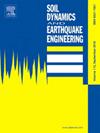Small strain stiffness degradation of MICP-treated sand and silt
IF 4.2
2区 工程技术
Q1 ENGINEERING, GEOLOGICAL
引用次数: 0
Abstract
Microbially Induced Carbonate Precipitation (MICP) can significantly improve the mechanical properties of soils through cementation between grains. The last two decades of research have demonstrated that MICP increases the stiffness and shear strength of geomaterials, as well as reducing their hydraulic conductivity and liquefaction potential. However, few studies have focused on the effects of MICP on the cyclic and dynamic behavior of soils, which is of fundamental importance in earthquake-prone countries. For instance, it is unclear whether medium-intensity earthquakes can totally or partially destroy MICP cementation, causing the material to lose the improvement of its properties long before a significant seismic event occurs. This paper presents a study of the cyclic behavior of two types of soils treated with MICP. The main objective is to evaluate the shear modulus degradation of MICP-treated soil and define the range of cyclic strain amplitude in which bio-cementation is effective in improving soil dynamic properties. Silty sand and silty tailings are tested through combined Resonant Column and Torsional Shear tests. Modulus degradation curves and damping are compared with untreated material. It was found that silty sand reaches a strain threshold where the effect of bio-cementation is lost, whereas in silty tailings the effect is maintained at all applied strain amplitudes.
micp处理砂粉的小应变刚度退化
微生物诱导碳酸盐降水(MICP)可以通过颗粒间胶结作用显著改善土壤的力学性能。过去二十年的研究表明,MICP增加了岩土材料的刚度和抗剪强度,同时降低了其导电性和液化潜力。然而,很少有研究关注MICP对土壤循环和动力行为的影响,这在地震易发国家是至关重要的。例如,目前尚不清楚中等强度地震是否能够完全或部分破坏MICP胶结,导致材料在重大地震事件发生之前很久就失去其性能的改善。本文研究了两种类型的土壤经MICP处理后的循环特性。主要目的是评估micp处理土壤的剪切模量退化,并确定生物胶结有效改善土壤动力特性的循环应变幅值范围。采用共振柱和扭剪联合试验对粉砂和粉砂尾砂进行了试验。与未处理材料的模量衰减曲线和阻尼进行了比较。研究发现,粉质砂达到一定的应变阈值时,生物胶结效应消失,而在粉质尾矿中,生物胶结效应在所有施加的应变幅值下都保持不变。
本文章由计算机程序翻译,如有差异,请以英文原文为准。
求助全文
约1分钟内获得全文
求助全文
来源期刊

Soil Dynamics and Earthquake Engineering
工程技术-地球科学综合
CiteScore
7.50
自引率
15.00%
发文量
446
审稿时长
8 months
期刊介绍:
The journal aims to encourage and enhance the role of mechanics and other disciplines as they relate to earthquake engineering by providing opportunities for the publication of the work of applied mathematicians, engineers and other applied scientists involved in solving problems closely related to the field of earthquake engineering and geotechnical earthquake engineering.
Emphasis is placed on new concepts and techniques, but case histories will also be published if they enhance the presentation and understanding of new technical concepts.
 求助内容:
求助内容: 应助结果提醒方式:
应助结果提醒方式:


